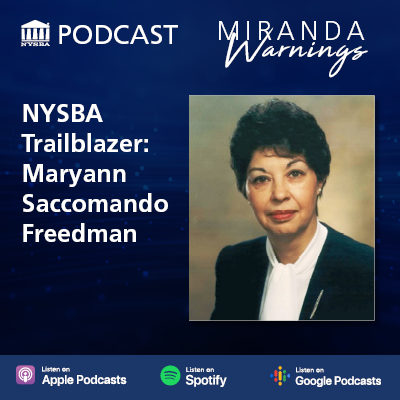What the Equal Rights Amendment Will Mean in New York
3.18.2024

On Nov. 5, 2024, New York voters will be asked to decide whether New York amends its constitution to include an equal rights amendment. Below is a discussion of the amendment and its path to the ballot as well as its potential impact on the rights and protections of New York’s citizens.
The timing of this amendment could not be more critical because the state constitution does not adequately ensure equality. Fundamental protections and rights for many individual groups are increasingly being dissolved throughout the country, including the reversal of Roe v. Wade and the recent Alabama Supreme Court ruling that would have held in vitro fertilization providers subject to criminal prosecution. The New York State Bar Association has advocated for the ERA by voicing its support of the Women in Law Section’s resolution for the amendment.
Listen to the podcast below:
We also provide a video version on YouTube:
The New York State Constitution contains enumerated protections prohibiting discrimination based only on race and religion. There are no such protections for gender or other classifications. The ERA as it will appear on the November ballot would prohibit discrimination based on a person’s ethnicity, national origin, age, disability and sex, including their sexual orientation, gender identity, gender expression, pregnancy and pregnancy outcomes. It would also protect against any government actions that would curtail a person’s reproductive autonomy or access to reproductive health care.
New York Senate Bill 108A, a concurrent resolution, passed both houses of the New York State Legislature within the required two consecutive legislative sessions (2021–22 and 2022–23) . The current amendment to New York’s Constitution was introduced as a concurrent resolution of both houses on July 1, 2022. It passed the Senate on the same day by a 49-14 vote. It was then transferred to the New York Assembly that day, where it passed by a 95-45 vote. As is required by Article XIX, Sec. 1 of the New York State Constitution (Amendments to Constitution), the concurrent resolution was again introduced in the following Legislative Session (2022–23). On Jan. 24, 2023, it passed the Senate 43-20. On the same day, it passed the Assembly 97-46. The measure was then referred to the ballot.
Most states have an equal rights amendment in their constitutions, particularly regarding gender. Twenty-nine state constitutions contain provisions that guarantee equal rights either in their original constitutional text or added as an amendment. Nevada was the last state to adopt an equal rights provision in its state constitution when, in 2022, voters passed Question 1, which, like the New York proposal, included sex, sexual orientation, gender identity or expression, age, disability, ancestry or national origin.[1]
If passed, this referendum amends the New York State Constitution Art 1, Section 11: Equal Protection of Laws; Discrimination in Civil Rights Prohibited. The full text of the amendment is as follows:
- No person shall be denied the equal protection of the laws of this state or any subdivision thereof. No person shall, because of race, color, ethnicity, national origin, age, disability creed, or religion, or sex, including sexual orientation, gender identity, gender expression, pregnancy, pregnancy outcomes, and reproductive healthcare and autonomy, be subjected to any discrimination in their civil rights by any other person or by any firm, corporation, or institution, or by the state or any agency or subdivision of the state pursuant to law.
- Nothing in this section shall invalidate or prevent the adoption of any law, regulation, program, or practice that is designed to prevent or dismantle discrimination on the basis of a characteristic listed in this section, nor shall any characteristic listed in this section be interpreted to interfere with, limit, or deny the civil rights of any person based upon any other characteristic identified in this section.
The sponsor memo for the original legislation states that the purpose of the amendment is that
[all] New Yorkers deserve a constitution that recognizes that every person is entitled to equal rights and justice under the law regardless of who they are, whom they love, or what their families look like. Because the New York Constitution’s Bill of Rights does not contain a comprehensive equal rights provision, a constitutional amendment is necessary to realize the promise of legal equality and justice for all New Yorkers and to create a clear mechanism to address and defend against violations of those rights. Our modern vision of equality demands comprehensive equal protection. Indeed, many individuals are themselves members of numerous communities, identities, and protected classes, and true equality and justice demand protections that recognize the interconnected nature of discrimination.
Opponents of the amendment were concerned about implications for religious institutions and freedom of religion. The second paragraph of the amendment now states directly that nothing in the amendment is intended to diminish existing protections outlined in Articles III and XI of New York’s Constitution. U.S. Supreme Court cases, including the Hobby Lobby[2] decision and 303 Creative,[3] also remain the law.
As this amendment is discussed, two questions are often asked. The first is, “Doesn’t New York already have an ERA?” and the second is, “Is this an expansion of rights?”
The first can be answered simply: no, New York State does not have an equal rights amendment to its Constitution. Nowhere are these protections delineated in the constitution.
The second question can be answered in two parts: first, yes, New York has many anti-discrimination laws. The New York Human Rights Law prohibits discrimination on the basis of “age, race, creed, color, national origin, sexual orientation, military status, sex, marital status or disability” in employment, housing, education, credit and access to public accommodations. The New York Reproductive Health Act of 2019 and the Marriage Equality Act of 2011, amongst other laws, prohibit discrimination and outline various rights. Second, while these protections are part of the codified laws of New York State, there is no constitutional protection. This means that judicial review of any alleged discrimination under the categories of gender, gender identity, sex, age, disability, et al. is based on intermediate scrutiny, a lower standard than that provided to constitutional protections. And while laws can be altered each legislative session, any amendment to New York’s Constitution must follow the constitutionally mandated complicated path the ERA has traveled to the ballot.
The New York State Assembly’s lead sponsor of the ERA, Rebecca Seawright, spoke during the WILS Symposium at the Annual Meeting. In the article she wrote for the upcoming edition of WILS Connect, the section’s biannual magazine, Seawright says:
[T]he fact is we need broader safeguards against discrimination. Our state statutes in place today can be superseded significantly more easily than overturning the enshrining of equal rights in our state constitution. We stand at a critical moment for equal rights. As courts and legislatures across America strip away women’s rights, harm LGBTQ+ individuals, and create challenges for people with disabilities, the time has come for New York to legally recognize the equality of all its residents.[4]
At the symposium, former Congresswoman Carolyn Maloney, who served as keynote speaker, discussed three potential impacts of an ERA on both the state and federal level. Maloney outlined the connection of a constitutional amendment to closing the pay gap, which is wider for women of color. It would assist not only women but also the nation’s economy. She also pointed to the importance of such an amendment to reducing gender-based violence. Her third point, which is addressed in the New York amendment, was that an ERA would allow women to make their own health care and reproductive decisions.[5]
As stated above, the New York referendum, which is broader than the federal ERA proposal, explicitly prohibits discrimination based on a person’s ethnicity, national origin, age, disability or sex, including sexual orientation, gender identity, gender expression, pregnancy, pregnancy outcomes and reproductive healthcare and autonomy. These are protections to secure individual rights against changing political tides. They also provide a means to codify meaningful equity-based safeguards in the New York State Constitution for large groups of citizens who do not have those protections, including women.
While political debates in states such as Alabama play out over court decisions impacting the very personal issues of infertility, in vitro fertilization and family planning,[6] New York’s ERA referendum allows voters to halt the confusion, government intrusion and deliberation on such decisions by including critical individual rights and protections in the state’s constitution.
The Women in Law Section provided a full day of programming at the 2024 Annual Meeting on the implications of the New York Equal Rights Amendment: “Each One Reach One: Educating Our Community About the ERA.”
The Women in Law Section will continue to sponsor programs throughout the year on this ballot referendum. In addition, the next issue of WILS Connect will focus on the Equal Rights Amendment. This all follows the section’s work in 2022 on a resolution and report to the New York State Bar Association resulting in its support of the concurrent ERA resolution.
The people of the State of New York will have the final say on Nov. 5, 2024, by flipping their ballots to determine whether New York’s Constitution will be amended to include a broader, more complete definition of equal rights.
Kimberly Wolf Price is the chief strategy and diversity officer at Bond Schoeneck & King. She is the chair of NYSBA’s Women in Law Section, a member of NYSBA’s Committee on Diversity, Equity and Inclusion and the former chair of the Lawyers in Transition Committee. This article will appear in a special issue of WILS Connect on the ERA (forthcoming). For more information, please visit NYSBA.ORG/WILS.
[1] See Brennan Center for Justice, www.brenncenter.org.
[2] Burwell v. Hobby Lobby Stores, Inc., 573 U.S. 682 (2014).
[3] 303 Creative LLC v. Elenis, 600 U.S. 570 (2023).
[4] WILS Connect, vol. 5, no. 1 (2024; forthcoming).
[5] Representative Maloney’s remarks will be published in the next issue of WILS Connect.
[6] LePage v. Center for Reprod. Med., P.C. (SC-2022-0515 Feb. 16, 2024).






